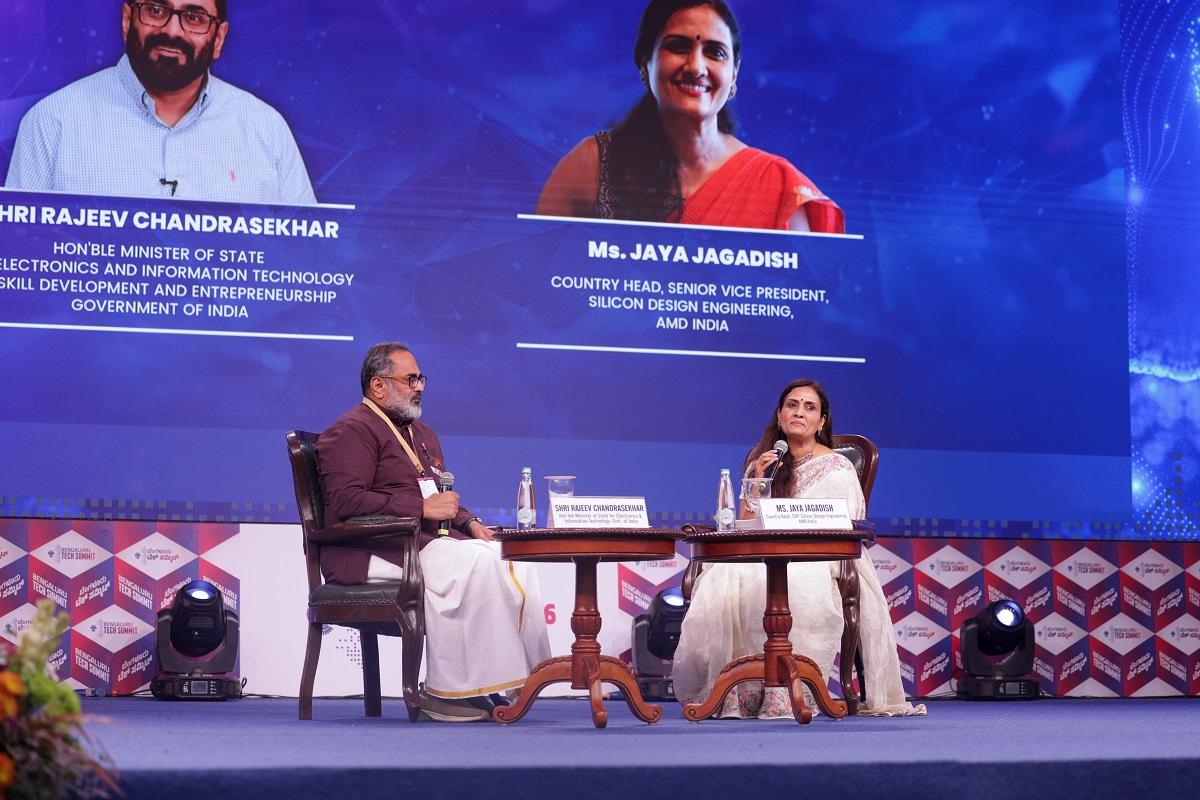The government sees artificial intelligence (AI) technology as a ‘kinetic enabler’ for the $1 trillion digital economy goal by 2026, Minister of State for Electronics and Information Technology Rajeev Chandrasekhar said on Thursday evening. However, he said that the world is now also aligning with India’s view that there is a need for guardrails of safety and trust in the area of AI.
“While AI is great, and the ChatGPTs of the world are very fancy along with other buzzwords, we need legislative guardrails that have safety and trust that will ensure that AI can never be misused or used by bad actors to cause harm,” said Chandrasekhar during a fireside chat at the Bengaluru Tech Summit.
He said the preference is for safe and trusted AI technology that has an unambiguous definition compared to responsible AI, which can be interpreted differently at an individual level.
But Chandrasekhar is of the view that AI is the biggest and most impactful invention in recent times. If harnessed correctly, it can transform sectors such as healthcare, agriculture, governance as well as language translation and inclusion.
“We are focused on capturing AI and building the capabilities and data sets and AI-compute and training capacities to build models that will help India’s quest to give better healthcare, education, language translation, and agriculture,” said Chandrasekhar.
He said that January 10, 2024, will see the launch of the global summit on India AI. The focus would be on AI-related talent, computing, chips, large language models (LLMs), and foundation models.
“We see AI as a kinetic enabler for the $1 trillion digital economy goal that we set for ourselves as a nation,” said Chandrasekhar. “So it’s a very big deal for us.”
The minister recently attended the AI Safety Summit 2023, which was held in Bletchley Park, Buckinghamshire in the United Kingdom, where 28 nations, including the US and China, participated. The nations which participated in the summit agreed to the ‘The Bletchley Declaration’. The document underscores the importance of aligning AI systems with human intentions and encourages a more in-depth exploration of the full potential of AI.
Regarding the progress in the area of semiconductors, Chandrasekhar said that the country is now designing devices today for the AI world, for which there is no legacy. In the last 18-24 months, India has made tremendous progress in areas such as talent, design, and packaging. The government is planning to set up the India Semiconductor Research Centre (ISRC). A few semiconductor fabrication plants are also expected to be built.
“For India to become a semiconductor nation and in turn, a trusted player in the global semiconductor ecosystem, is a question of how fast we can roll it out, and how soon we will get there,” said Chandrasekhar.
He said that India’s engagement with semiconductors has been a series of missed opportunities over the last 70 years. Fairchild Semiconductor veterans Robert Norton Noyce and Gordon Earle Moore, who are also known as Intel co-founders, wanted to set up the first packaging unit in India. Due to the socialist policies, they couldn’t do that in the country. Chandrasekhar said that they then went on to build it in Penang, Malaysia, which is now one of the largest packaging hubs in Asia. Also, in mid-2010, Chandrasekhar said that Intel wanted to set up a Fab in India and again it got thwarted by the government red tape.
“I think we are now playing catch up,” said Chandrasekhar. “But funnily enough we are almost jumping one generation and looking at opportunities for the next decade. Designing devices today for the AI world is something that there is no legacy for.”
Earlier there was scepticism about India becoming the place of action for semiconductors as there are already locations which are hubs for this including Taiwan, the US, and Europe. However, that narrative is changing from ‘Why India to when are we going to do this in India and why we are not present in the country’, according to Chandrasekhar. Apart from the geopolitics, he said the reason is the increasing confidence and the capabilities of the ecosystem.
After the Y2K (year 2000 problem), the economy had been predominantly focused on IT and ITEs. However, over the last 5-7 years, Chandrasekhar argued that India’s tech economy is present in every aspect of innovation around the world. This includes AI, semiconductors, electronics, Web3, supercomputing and the consumer internet as well as IT.
“We are at a stage today where young startups believe that they can design devices, IP products, solutions, and platforms for the world and the Indian market,” said Chandrasekhar. “That confidence has never been seen before. This is certainly the most exciting time ever in the history of independent India. The world is recognizing that India is a trusted, global, reliable partner.”
Indeed, tech city Bengaluru has swiftly expanded and diversified its capabilities from helping build global companies like Infosys and Wipro to housing the R&D centre of every semiconductor major including AMD, Applied Materials, Lam Research, Intel, and Fujitsu. “Engineering of the next generation of devices is happening here,” said Chandrasekhar. “The Hyderabad-Bengaluru competition is legendary. But I think it’s no competition. Bengaluru’s talent base today is recognized by the world like no other city outside of Silicon Valley.”
In the past, the economy, according to Chandrasekhar, was controlled by a few large and diversified groups. But today, a large amount of economic activity and GVA (gross value added) is coming from startups. There are about 102 unicorns, and $65 billion of foreign direct investment (FDI) has gone into the startups. Now, these firms are not just an important part of the technology vision, but the overall economic ambition as well. Earlier, it had been about talent arbitrage in the IT and ITES space and the scale of the market in the area of consumer internet. Now there is a movement towards true R&D, IP, and product innovation.
“As we push the envelope on technology and move to AI and semiconductors, more startups would emerge that are very valuable for their intellectual property,” said Chandrasekhar.
Note:- (Not all news on the site expresses the point of view of the site, but we transmit this news automatically and translate it through programmatic technology on the site and not from a human editor. The content is auto-generated from a syndicated feed.))



